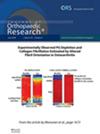Extensive Periosteal Injury During Fracture Induces Long-Term Pain in Mice
Abstract
Bone fractures pose a significant public health challenge, often necessitating surgical interventions to facilitate bone healing and functional recovery. Sensory nerve fibers innervate various compartments of the bone tissue, with the periosteum exhibiting the most extensive innervation that is susceptible to injury during trauma. Despite its importance, the effect of injured periosteum on fracture pain remains unknown. This study examines the impact of extensive periosteal injury on fracture pain by using a mouse model. Periosteal injury is induced by mechanical resection during unilateral transverse fracture and compared to transverse fractures with no periosteal injury. Our results demonstrate that extensive periosteal injury induces severe and long-term pain, as assessed by von Frey and dynamic weight bearing measurements, for up to 12 weeks postfracture. Immunofluorescence staining revealed an increase in local neurofilament heavy polypeptide (NF200 +) nerve innervation and an elevated number of calcitonin gene-related peptide (CGRP +) expressing neurons in the dorsal root ganglion (DRG). Additionally, flow cytometric analyses revealed increased presence of myeloid immune cells in the DRG. Furthermore, bone healing in fractures with extensive periosteal injury exhibited reduced callus size at all time points as assessed by Faxitron X-ray imaging. This study describes a previously unknown effect of extensive periosteal injury in exacerbating fracture pain and establishes a potential model to study long-term orthopedic fracture pain.

 求助内容:
求助内容: 应助结果提醒方式:
应助结果提醒方式:


